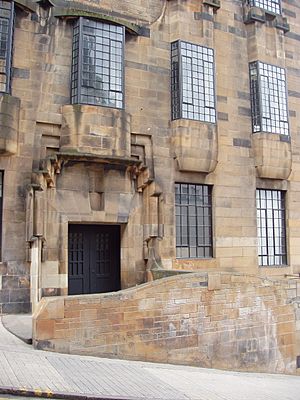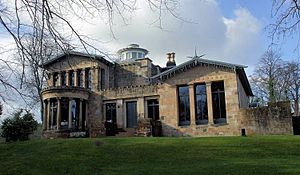Architecture of Glasgow facts for kids
The city of Glasgow, Scotland, is famous for its amazing buildings. Many of them were built in the 1800s, during the Victorian era. There's also a special style called the "Glasgow Style," created by a famous architect named Charles Rennie Mackintosh.
Not many buildings from Glasgow's very old days (the Middle Ages) are still standing. Two important ones are Provand's Lordship, built in the 1400s, and St. Mungo's Cathedral, from the 1100s. St. Mungo's Cathedral is the oldest building in the city. It's a great example of Gothic architecture, which has tall, pointed arches and big windows.
Most of Glasgow's buildings you see today were built in the 1800s. This means the city has many beautiful Victorian buildings. Good examples include the Glasgow City Chambers, the main building of the University of Glasgow, and the Kelvingrove Art Gallery and Museum.
Contents
What is the Glasgow Style?
Glasgow is well-known for buildings designed by Charles Rennie Mackintosh (1868–1928). Mackintosh was an amazing architect and designer. He was part of the Arts and Crafts movement and a key person in Art Nouveau in the United Kingdom.
He designed several famous Glasgow buildings. These include the Glasgow School of Art, the Willow Tearooms, and the Scotland Street School. Mackintosh also designed the Queen's Cross Church. This is the only church he ever built.
Buildings from the Victorian Era
Another architect who greatly shaped Glasgow was Alexander Thomson (1817–1875). Thomson created a unique style of architecture. It was based on very old Greek and Roman designs. This earned him the nickname "Greek" Thomson.
You can find Thomson's work all over the city. Famous examples include the Holmwood House villa and St. Vincent Street Church. These buildings show how rich and confident Glasgow was. It was known as the "Second City of the Empire."
Glasgow became wealthy from trade and new industries. These grew during the Industrial Revolution. The Templeton's carpet factory on Glasgow Green was built to look like the Doge's Palace in Venice. This shows how much Glaswegians wanted to display their wealth through grand buildings.
Many of Glasgow's buildings were made from red or blond sandstone. But during the industrial age, these colors disappeared. A thick layer of black soot and pollution covered them. This came from all the factories and furnaces.
Things changed after the Clean Air Act was passed in 1956. In recent years, many of these buildings have been cleaned. They now look like their original beautiful selves again.
Victorian Churches in Glasgow
Many important churches were built in Victorian Glasgow. They often copied older styles of architecture. Examples include the St. Vincent Street Church and the Garnethill Synagogue. The synagogue was built in a style that looked like old Roman buildings.
Modern Buildings in Glasgow
Glasgow also has many cool modern buildings. These include the Glasgow Royal Concert Hall. Along the River Clyde, you can find the Glasgow Science Centre. There's also the Scottish Exhibition and Conference Centre. Its Clyde Auditorium was designed by Sir Norman Foster. People often call it the "Armadillo" because of its shape.
Zaha Hadid, another famous architect, designed the new Riverside Museum. This museum is home to the Glasgow Museum of Transport.
Glasgow's mix of old and new architecture was celebrated in 1999. The city was named the UK City of Architecture and Design. It won this special award over other big cities like Liverpool and Edinburgh.





